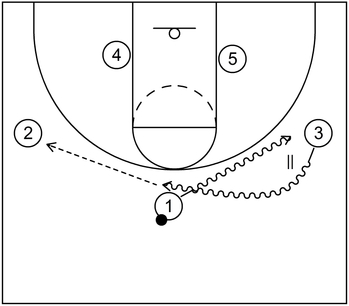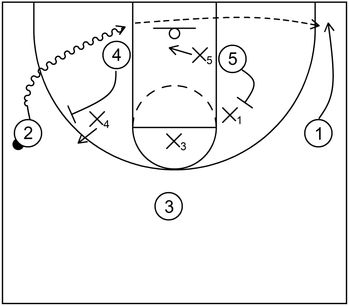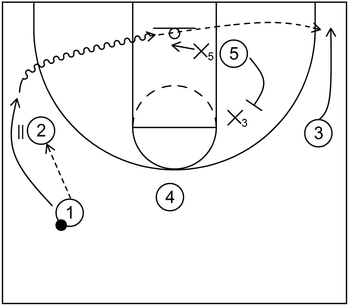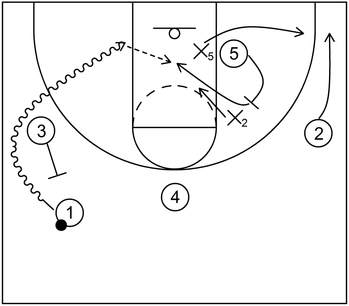What is the hammer set play in basketball
The hammer set play consists of offensive action that occurs when a weak side player cuts to the nearby corner, usually by way of a screen, and afterwards, that same weak side player could receive the ball from another player who is typically near the strong side baseline, which then commonly results in a three-point attempt.
Why is the hammer set play potentially effective
The hammer set play is potentially effective because it essentially causes defensive breakdowns, especially on the weak side, which could then lead to a possible scoring opportunity, particularly from three-point range or in some instances, additional playmaking opportunities.
In other words, the hammer set play is beneficial for the offensive team more often than not because it is generally difficult for the defense to productively guard on-ball actions on the strong side and off-ball actions, particularly on the weak side, at the same time.
To further explain, during the hammer set play, when the basketball is near the baseline on the strong side of the court, especially because of dribble penetration, this influences the weak side perimeter defender that is guarding an offensive perimeter player to generally slide towards the lane line on that weak side.
Additionally, if there is another weak side defender guarding an offensive player near the low post block, then that same defender would typically slide towards the basket in the lane to mitigate or eliminate uncontested layups or dunks.
The hammer set play basically misdirects those weak side defenders into thinking that offensive action such as a jump shot or floater would come from the strong side. However, the real action occurs on the weak side.
That is to say, once the weak side defenders move towards the ball that is on the strong side, which is ironically good help defense in most instances, those defenders would then be too far away from the weak side perimeter player, who is the real target of the hammer set play.
Furthermore, if the weak side perimeter defender that is guarding the weak side offensive perimeter player gets caught on a screen by a weak side screener, then that effectively leaves the offensive perimeter player open for a three-point attempt.
Granted, it is possible for the weak side screener’s defender to execute a defensive closeout on the perimeter three-point shooter.
The problem though, is that the closeout executed by the screener’s defender would most likely be too late, which is too much time and space for an above average mid-range or three-point shooter.
What is a brief history of the hammer set play
Historically, in terms of its origin, the hammer set play was initially an after timeout play, or ATO, developed by George Karl during his time as the head coach of the Milwaukee Bucks NBA team.
According to Darvin Ham, who was a former player of the Milwaukee Bucks during the time of the original hammer action, he would receive the ball in the low post area and then execute a spin move towards the baseline.
Afterwards, Darvin would essentially pass the ball across the lane to one of the Bucks’ three-point shooters such as Ray Allen or Michael Redd, near the weak side corner.
It should also be noted that the hammer play is basically named after Darvin Ham as well.
Related: Darvin Ham On Creation Of “The Hammer Play” – YouTube
A few years later, Gregg Popovich, the head coach of the San Antonio Spurs further expanded the original hammer set play, which effectively included baseline dribble penetration on the strong side alongside the screening action on the weak side to free up a three-point shooter.
Generally speaking, Coach Popovich would commonly utilize a primary ball handler such as Tony Parker or Manu Ginóbili to dribble penetrate towards the strong side baseline and while that happened, another player such as Tim Duncan would set a weak side screen for one of the team’s best perimeter shooters such as Danny Green, who would cut to the weak side corner.
Afterwards, the primary ball handler on the strong side would throw a drift pass to the corner player on the weak side and from there, that same weak side corner player would usually be open for a three-point jump shot.
Related: San Antonio Spurs “Hammer” Set – YouTube
What are basic examples of the hammer set play
Example 1 – Part 1

This is a basic example of the hammer set play initiated from a 3 out 2 in alignment and it could generate a quick hitting three-pointer for the team’s point guard.
To begin the action, 1 executes a dribble handoff with 3 near the right side wing. Following that, 3 dribbles back to the top and then 2, who is near the left side wing, receives the ball from 3.
Example 1 – Part 2

Next, 4 lifts up to set a side ball screen for 2. However, X4, who is guarding the screener, decides to implement a defensive hedge to mitigate dribble penetration, particularly towards the middle.
Furthermore, X3 is in position to protect the nail area, which further prevents easy middle penetration. So, to counter that action, 2 simply rejects the screen and dribbles toward the left side baseline area.
At the same time, X5 slides towards the basket in the lane while X1 covers the area near the right side lane line slightly below the right side high post elbow.
Afterwards, it is quite possible that both X5 and X1 will look at the ball and this allows the hammer set play to exploit those weak side defenders.
Therefore, 1 cuts to the right side corner by way of a hammer screen set by 5 and receives the ball from 2 via a drift pass. If X1 gets caught on that screen, then 1 would have a wide open three-point jump shot available.
Example 2

This is a basic example of a hammer set play derived from the Pistol offense, which seeks to score early and efficiently. This play can also be ran during transition offense, especially during secondary break or after a timeout occurs.
To start, 2 receives the ball from 1 and after that, 1 receives it again via give and go handoff action. Next, 1 dribbles toward the baseline, which influences X5 to slide towards the basket.
As that happens, 3 cuts to the corner by way of the hammer screen set by 5. Following that, 3 receives the ball from 1 via the drift pass and then takes the open three-point jump shot.
Example 3

This is a basic example of a hammer set play, also derived from the Pistol offense, but this time with an on-ball screen as opposed to a handoff.
To begin, 1 quickly dribbles toward the left side baseline area via the on-ball screen set by 3. However, as that happens, X2 and X5 execute defensive switching as a counter to the hammer screen.
Therefore, when 2 cuts to the right side corner, X5 moves toward 2 with high active hands, discouraging an easy pass to the right side corner. At the same time, X2 will cover 5, who set the initial hammer screen.
Nevertheless, the problem for the defense is that 5 could simply slip to the basket as an offensive counter to the defensive counter.
What that effectively means is that no matter which of the two offensive players involved in the hammer action, it would always result in a defensive mismatch.
So, if 5 receives the ball from 1, then 5 could simply score near the basket with a layup or dunk. Basically, X2 would be behind 5 after the slip action; therefore, X2 would most likely have to foul 5 to stop the layup or dunk from happening.
On the other hand, if 2 were able to receive the ball but the shot was not available due to a defensive closeout of X5, then that could lead to a few additional scoring options.
Essentially, 2 could pass the ball to 5, who would be currently matched with X2. From there, 5 could easily score with a potential layup, dunk, or low post move.
Moreover, 2 could possibly beat X5 with speed and quickness off the dribble and drive to the basket for a possible scoring or playmaking opportunity.
In addition to that, 2 could utilize a type of dribble move such as a step back to create space for a potential mid-range or three-point jump shot against X5.
Related: Pistols Basketball Offense Plays that Work – YouTube